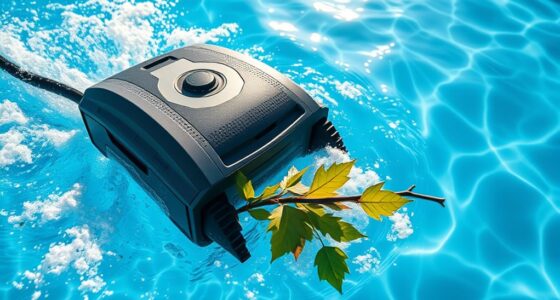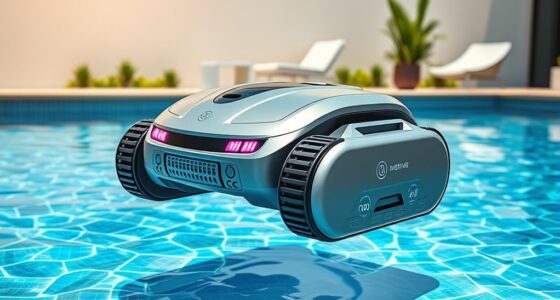Suction pool cleaners work by using your pool’s existing filtration system to create vacuum pressure that pulls debris from the surface and floor. As the pump runs, water flows through the cleaner’s hose and body, guiding debris into filters or bags for removal. These cleaners move across the pool, steering around features and obstacles. To understand how different designs enhance cleaning, keep exploring how they operate and maintain optimal performance.
Key Takeaways
- Suction pool cleaners use the pool’s filtration system to create vacuum pressure that pulls debris from the pool surface.
- They rely on water flow generated by the pump to move the cleaner and carry debris to the filter.
- The cleaner’s body contains brushes or jets that loosen debris for easier removal.
- Suction is maintained through sealed connections and hoses that direct debris to the filter basket or bag.
- Movement patterns, either random or programmed, ensure the cleaner covers the pool surface efficiently.
Components of a Suction Pool Cleaner

A suction pool cleaner relies on several key components working together to keep your pool clean. The first is the suction inlet, which pulls debris from the pool surface. Connected to this is the hose, which channels water and debris to the filter. The filter itself traps dirt, leaves, and other particles, preventing them from recirculating. Water circulation plays a crucial role here, ensuring debris gets moved toward the cleaner and through the system. Proper water flow also helps maintain balanced pool chemicals, reducing algae and bacteria buildup. The cleaner’s body contains brushes or jets that loosen debris from the pool floor and walls. All these components work in harmony, creating an effective cleaning system that keeps your pool sparkling without manual effort. Additionally, appliance features such as adjustable settings and energy-efficient operation can enhance the overall performance of your suction pool cleaner. Understanding pool maintenance principles can help optimize the cleaner’s efficiency and extend its lifespan, especially as regular filter cleaning prevents clogs that hinder performance. Incorporating vertical storage solutions for your cleaning tools can also streamline your pool maintenance routine and keep equipment in good condition.
How Suction Is Created in the System
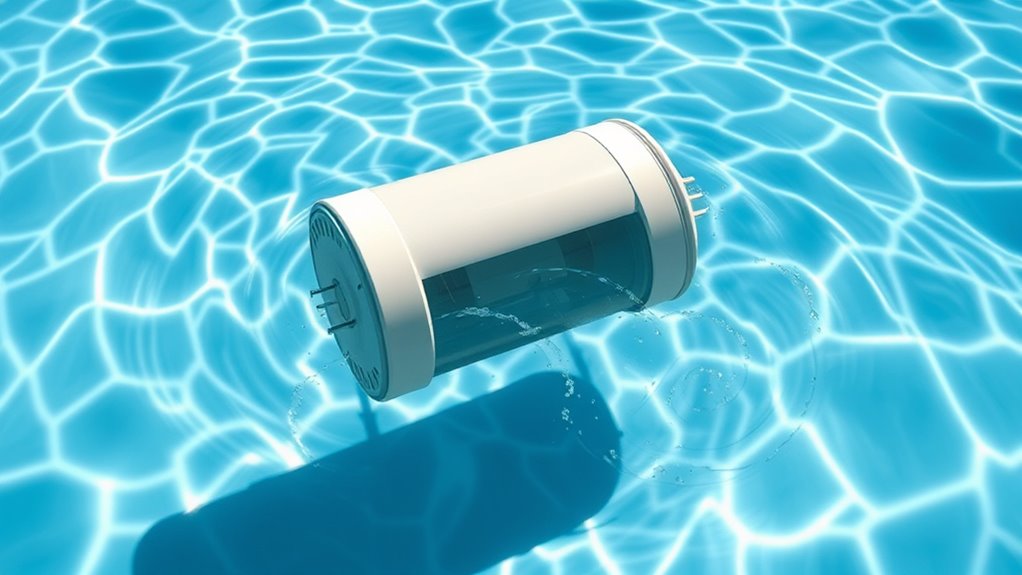
You might wonder how suction pulls debris from your pool. It all starts with the pump mechanism, which creates water flow that generates vacuum pressure. This pressure difference then draws in dirt and leaves, making your cleaner effective and efficient. Additionally, the design of the system often incorporates high flow rates to maximize debris removal and ensure thorough cleaning. Properly maintained pumps and filters are essential to sustain optimal suction power over time.
Pump Mechanism Functionality
Ever wonder how suction pool cleaners generate the powerful pull needed to trap debris? It all comes down to the pump mechanism. This system creates suction by pulling water through the cleaner, which then captures debris. Here’s how it works:
- The pump motor activates, creating a vacuum that draws water into the system.
- Water circulation ensures debris is directed toward the intake, aided by the cleaner’s design.
- Properly balanced pool chemicals help maintain ideal water quality, preventing clogs and ensuring smooth operation.
- The efficiency of the pump depends on the water flow, which is influenced by the system’s design and maintenance.
The pump’s ability to generate consistent suction relies on the system’s design and the water’s flow. By maintaining clean filters and balanced chemicals, you ensure the pump runs efficiently, keeping debris out of your pool and maintaining water clarity.
Water Flow Dynamics
Water flow dynamics are fundamental to creating the suction that powers your pool cleaner. When your pump operates, water is drawn through the skimmer and drain, increasing flow velocity. This movement creates a pressure difference, generating suction that pulls debris into the cleaner. Maintaining proper chemical balance ensures ideal water flow and prevents clogs or restrictions that could weaken suction. A balanced chemical level also helps prevent algae buildup, which can obstruct flow paths and reduce cleaning efficiency. As water moves through the system, it carries dirt and debris toward the pump’s filter, allowing the cleaner to effectively remove particles from the pool. Understanding how water flow dynamics work helps guarantee your suction pool cleaner operates smoothly and maintains a clean, algae-free pool. Proper water circulation is essential for preventing stagnation and ensuring consistent cleaning performance. Additionally, optimizing water flow can improve overall system efficiency and prolong equipment lifespan, reducing the likelihood of system malfunctions. Correctly managing these processes involves not only adjusting the equipment but also being aware of how pool maintenance impacts water flow and system health.
Vacuum Pressure Generation
Vacuum pressure in your pool cleaner is generated through a carefully designed system that creates a pressure difference, or vacuum, necessary to lift debris from the pool floor. This process relies on a few key components working together:
- A pump or suction motor that draws water and creates negative pressure.
- Sealed connections that maintain energy efficiency, reducing power consumption.
- Safe operation features that prevent over-pressurization, ensuring user safety.
This setup allows the cleaner to generate consistent vacuum pressure without wasting energy or risking harm. By maintaining ideal pressure levels, the system efficiently picks up debris while conserving power. The design emphasizes user safety and energy efficiency, making your pool cleaning both effective and secure.
The Role of the Pool’s Filtration System
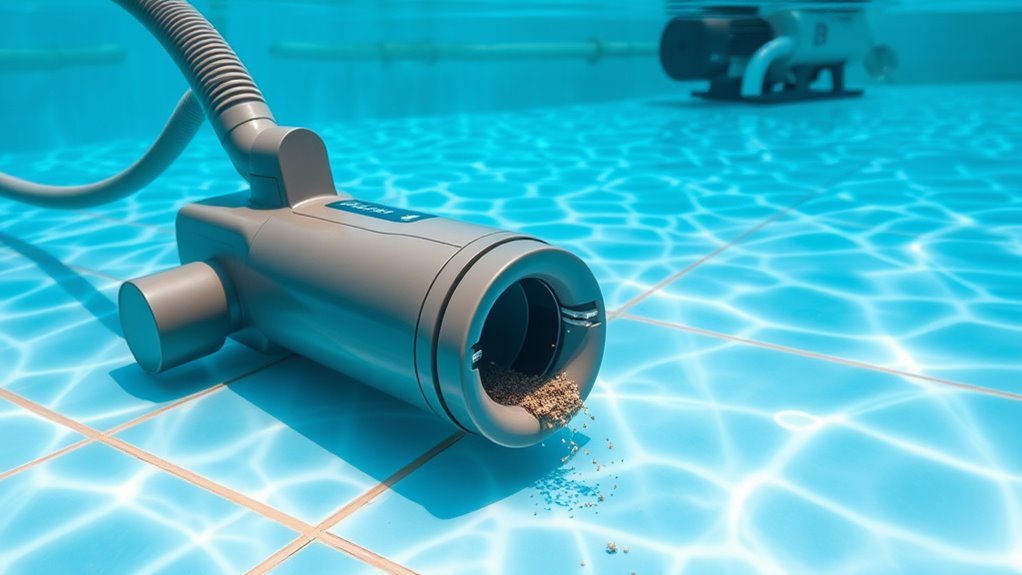
The pool’s filtration system plays a crucial role in maintaining clean and healthy water, especially when using a suction pool cleaner. It filters out dirt, debris, and algae, preventing clogs and ensuring efficient cleaning. Proper filtration helps keep chlorine levels balanced, which is essential for disinfecting your pool and controlling bacteria. Water temperature also affects the filtration process; warmer water can promote algae growth, making filtration more critical. When your system runs effectively, it improves water clarity and reduces chemical use. Regular maintenance of the filter ensures it functions at its best, supporting the cleaner’s ability to pick up debris. Additionally, the horsepower of electric dirt bikes can influence the overall efficiency of your pool cleaning equipment by enabling faster navigation and more thorough debris removal. Overall, a well-maintained filtration system works hand-in-hand with your suction cleaner to keep your pool sparkling and safe, and understanding how filtration efficiency impacts water quality can help optimize your pool maintenance routine.
Movement Mechanics of the Cleaner
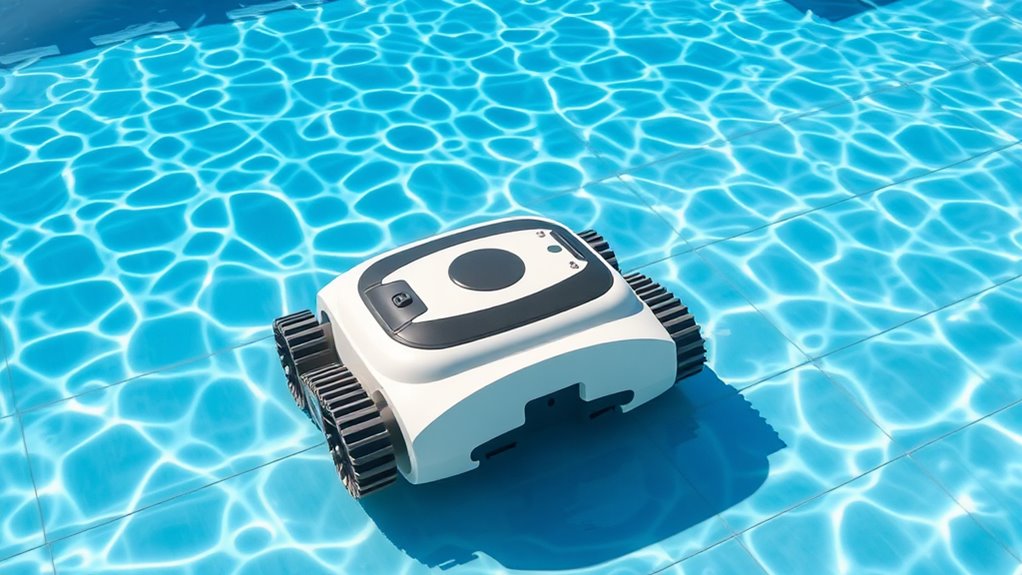
Suction pool cleaners move across the pool surface and floor by utilizing the flow of water created by their suction power. This flow propels the cleaner forward, allowing it to cover the pool efficiently. To optimize movement, you should consider these key factors:
- Proper Installation: Ensuring the cleaner is correctly connected to the skimmer or suction port helps maintain steady movement.
- Regular Maintenance: Clear debris from the filter and check for blockages to keep water flow consistent.
- Pool Chemistry & Safety: Maintain balanced chemicals to prevent corrosion of moving parts, and always follow pool safety tips when installing or servicing your cleaner. Additionally, selecting a cleaner with pressure regulation features can improve overall efficiency and prevent jamming during operation.
- Understanding the water flow dynamics within your pool can assist in troubleshooting and optimizing the cleaner’s movement. Being aware of how water pressure interacts with your pool’s circulation system can further enhance the cleaner’s performance. Regularly inspecting water flow patterns can help identify areas that may need better circulation, ensuring more effective cleaning. Incorporating proper pool design can also facilitate easier cleaning by promoting even water movement throughout the pool.
Navigation Patterns and Coverage
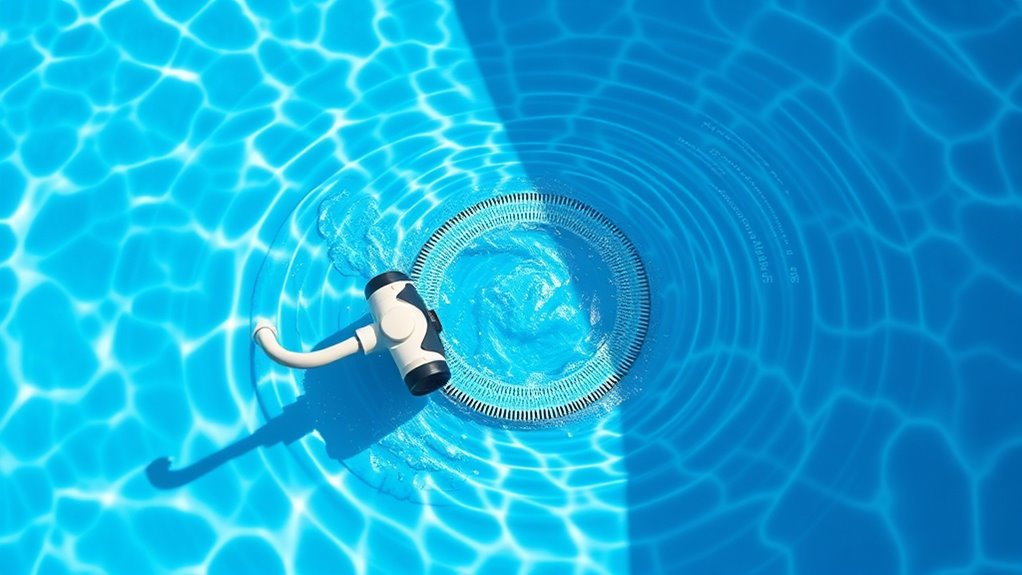
You’ll notice that suction pool cleaners follow either random or systematic paths to cover your pool effectively. They use obstacle detection methods to navigate around features and avoid getting stuck. To maximize coverage, these cleaners employ strategies like pattern optimization and area prioritization, ensuring your pool gets thoroughly cleaned. Incorporating smart navigation technology can further enhance their efficiency and thoroughness. Additionally, some models utilize coverage algorithms that adapt to pool shapes and obstacles for comprehensive cleaning. Leveraging advanced sensors allows these devices to better identify areas already cleaned versus those remaining, optimizing their cleaning routes even further. Employing efficient path planning techniques can significantly reduce cleaning time and improve overall performance.
Random or Systematic Paths
When it comes to maneuvering a pool’s surface, suction pool cleaners typically follow either random or systematic paths to guarantee coverage. Random paths rely on robotic navigation, where the cleaner moves unpredictably, covering most areas over time. Systematic paths, on the other hand, use planned routes, ensuring thorough cleaning with less overlap. To understand these patterns better:
- Random paths are simple, requiring no programming but may miss spots.
- Systematic paths involve programmed routes for consistent coverage.
- Manual cleaning is different, as you control the movement, but robotic navigation automates this process.
Choosing between these depends on your pool size and your preference for convenience versus precision. Both methods aim to optimize cleaning efficiency, with robotic navigation making automated cleaning more effective.
Obstacle Detection Methods
To guarantee thorough cleaning, suction pool cleaners rely on obstacle detection methods that guide their navigation patterns and coverage. They use debris sensors to identify obstacles like toys or pool edges, triggering the cleaner to change direction promptly. Proper sensor calibration ensures these sensors accurately detect debris and obstructions, preventing misses or collisions. Some models incorporate advanced obstacle detection systems that combine infrared or ultrasonic sensors with debris sensors for enhanced precision. When sensors sense an obstacle, the cleaner adjusts its path to avoid it, maintaining ideal coverage. This combination of debris sensors and calibrated obstacle detection helps the cleaner navigate efficiently, minimizing missed spots and reducing the risk of getting stuck. Ultimately, these methods ensure your pool remains spotless with minimal intervention.
Coverage Efficiency Strategies
Effective coverage is essential for ensuring your pool is thoroughly cleaned without missing spots or wasting time. Robotic algorithms optimize navigation patterns, allowing your cleaner to systematically cover the entire surface. To maximize efficiency, consider these strategies:
- Pattern Selection: Choose cleaners with intelligent algorithms that follow grid, wall-following, or randomized paths.
- Mapping Capabilities: Look for models with mapping features, which help the cleaner remember areas for faster coverage.
- User Interface Control: Use the user interface to set cleaning schedules, select zones, or manually guide the cleaner for spot cleaning.
How Debris Is Picked Up and Collected

Suction pool cleaners use powerful motors to generate strong water flow, which pulls debris from the pool floor and walls. As water moves through the cleaner, it creates suction that lifts leaves, dirt, and small particles into the intake. Once inside, the debris travels through hoses or internal chambers to be collected in a filter or bag. Pool chemicals and water temperature can influence debris collection; for example, algae growth in warm water can increase debris, making the cleaner work harder. Proper chemical balance helps prevent excessive buildup, ensuring the cleaner operates efficiently. Still, debris collection relies on consistent suction and filtration, so regularly checking and cleaning the filter or bag is essential for ideal performance.
The Importance of Pool Size and Shape

Your pool’s size and shape directly impact how effectively a suction cleaner works. Larger pools may require stronger suction, while the shape can influence the cleaner’s ability to cover every corner. Understanding these factors helps you choose the right cleaner for your pool’s dimensions and design.
Pool Dimensions and Efficiency
The size and shape of your pool play a crucial role in how well a suction pool cleaner performs. Larger pools may take longer to clean, affecting efficiency, while irregular shapes can create missed spots. To optimize performance, consider these factors:
- Pool dimensions influence robotic automation, determining the cleaner’s navigation and coverage.
- Larger pools require more energy-efficient models to save on power consumption.
- Unusual shapes may demand specialized cleaners for thorough cleaning without gaps.
Shape Influences Cleaning Path
Since the shape of your pool directly affects the cleaner’s ability to navigate, understanding how different designs influence the cleaning path is essential. A complex or irregular pool surface can create missed spots or longer cleaning times. Circular pools allow for smooth, consistent movement, while rectangular or freeform pools may require more meticulous coverage. Consider debris types too: larger leaves gather in corners, making shape vital for efficient debris removal. To visualize this, see the table below:
| Pool Shape | Cleaning Challenges |
|---|---|
| Circular | Easy to navigate, fewer missed spots |
| Rectangular | Corners may need extra attention |
| Freeform | Difficult to cover all areas |
| Kidney-shaped | Navigational complexity |
| Oval | Similar to circular, consistent path |
Knowing your pool’s shape helps optimize your suction cleaner’s efficiency.
Size Affects Suction Power
Pool size plays a crucial role in determining a suction cleaner’s effectiveness, as larger pools require more powerful suction to cover the entire area efficiently. When considering pool size, you should evaluate factors like:
- Pool depth – Deeper pools demand stronger suction to reach the bottom effectively.
- Surface texture – Rough or textured surfaces increase cleaning difficulty, needing more suction power.
- Pool dimensions – Longer or wider pools may require a cleaner with higher suction capacity for thorough coverage.
If your pool is large or has a complex surface texture, a suction cleaner with adjustable suction power becomes essential. Properly matching your pool’s size and shape ensures ideal cleaning performance and efficiency.
Maintenance and Troubleshooting

Regular maintenance is essential to keep your suction pool cleaner functioning effectively. Start by inspecting the battery operation regularly, ensuring the battery is charged and free of corrosion. If your cleaner has a rechargeable battery, avoid letting it fully discharge often, as this can reduce lifespan. Manual maintenance involves cleaning the brushes, filters, and suction ports to prevent clogs that hinder performance. Check for debris buildup and remove any obstructions promptly. If your cleaner isn’t moving properly or losing suction, examine the hoses and connections for leaks or blockages. Keep the wheels and brushes free of debris to ensure smooth operation. Troubleshooting common issues like reduced suction or motor problems can often be resolved with simple manual maintenance, prolonging the life of your cleaner.
Advantages of Suction Pool Cleaners
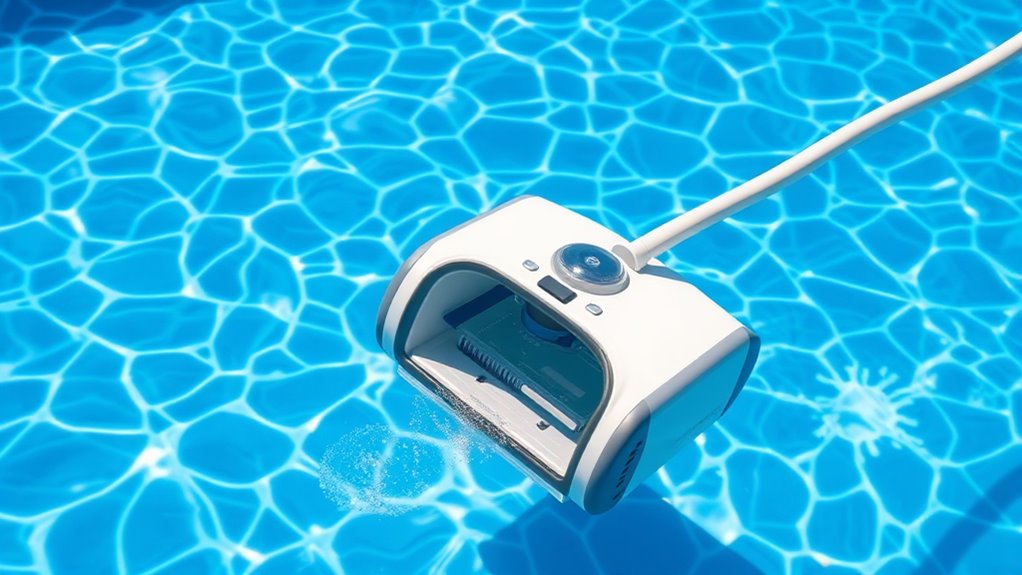
Suction pool cleaners offer several advantages that make them a popular choice for maintaining clean pools. First, they typically require less filter maintenance because their design minimizes debris buildup, saving you time and effort. Second, their motors are built for durability, ensuring long-lasting performance even with regular use. Third, these cleaners efficiently navigate pool surfaces, providing thorough cleaning with minimal supervision. Additionally, their simple design reduces the risk of mechanical failure, which means fewer repairs and peace of mind. Overall, suction cleaners deliver reliable performance, low maintenance needs, and cost-effectiveness—making them an ideal choice for keeping your pool spotless. Their ability to handle debris and maintain filter efficiency truly sets them apart.
Comparing Suction Cleaners to Other Types
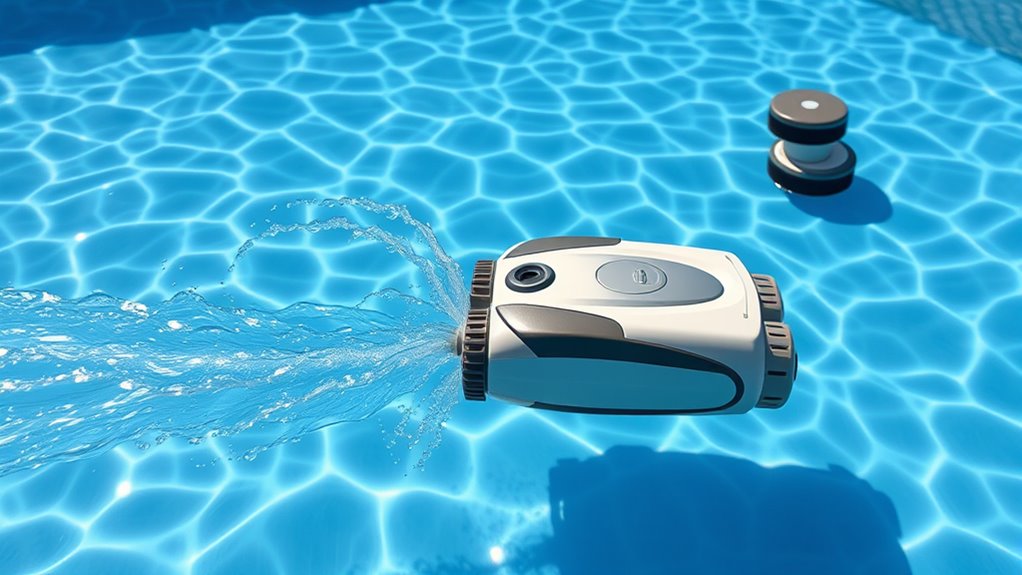
When comparing suction cleaners to other types like robotic and pressure-side cleaners, you’ll notice distinct differences in their operation and maintenance. Suction cleaners rely on simple suction power, making them easy to set up and maintain, but they lack advanced features. Robotic cleaners use robotic navigation to methodically cover the pool floor, often equipped with debris sensors that detect dirt and optimize cleaning paths. Pressure-side cleaners, on the other hand, use water pressure from your pump to propel themselves, covering large areas quickly. While robotic cleaners offer precise navigation and debris detection, suction cleaners are generally more affordable and straightforward. Each type suits different needs, but understanding these differences helps you choose the right cleaner for your pool’s size and debris levels.
Frequently Asked Questions
How Long Does a Typical Suction Pool Cleaner Operate Before Maintenance?
A typical suction pool cleaner runs about 8 to 12 hours per week, depending on your pool’s size and debris level. You should check the filter maintenance regularly—usually every 1-2 weeks—to keep it unclogged. Also, monitor motor durability; if you notice it slowing down or making unusual sounds, it’s time for maintenance or repairs. Proper care guarantees your cleaner operates efficiently and lasts longer.
Can Suction Pool Cleaners Handle Large or Sharp Debris?
You wonder if suction pool cleaners can handle large or sharp debris, and the answer’s not simple. These cleaners excel at small debris but might struggle with bigger, jagged pieces that could cause surface damage or clog the system. Debris size matters; sharp objects can puncture hoses or damage internal components. For safety, keep an eye on what you’re cleaning to prevent costly repairs and make sure your pool stays pristine.
Are Suction Pool Cleaners Suitable for All Types of Pool Surfaces?
You might wonder if suction pool cleaners suit all types of pool surfaces. They generally work well on smooth, painted, or tiled surfaces, but some models may struggle with pebble or rough finishes due to debris limitations. Always check your cleaner’s specifications for pool surface compatibility. If your pool has delicate or textured surfaces, select a cleaner designed specifically for that to avoid damage and ensure effective cleaning.
How Energy-Efficient Are Suction Pool Cleaners Compared to Robotic Models?
Imagine your pool’s cleanliness as a well-tuned orchestra. Suction pool cleaners often play a quieter, more energy-efficient tune compared to robotic models. They consume less energy, reducing your energy consumption and environmental impact. While robotic cleaners might sing a more complex melody, suction cleaners keep the performance simple and eco-friendly, letting you enjoy a sparkling pool without the harsh notes of high power use.
What Safety Precautions Should Be Taken When Using a Suction Pool Cleaner?
When using a suction pool cleaner, you should prioritize electrical safety by ensuring the power cord and plug are dry and undamaged. Always turn off the unit before handling it or performing maintenance. Handle pool chemicals carefully, keeping them away from the cleaner to prevent damage or hazards. Regularly inspect the device for leaks or wear, and never operate it in wet conditions that could compromise electrical safety.
Conclusion
Understanding how suction pool cleaners work helps you keep your pool spotless with ease. By harnessing powerful suction and smart movement, they turn a messy pool into a sparkling oasis effortlessly. Regular maintenance ensures they run smoothly, saving you time and effort. Think of these cleaners as the superheroes of pool care—invincible against dirt and debris. Mastering their operation means you’ll enjoy crystal-clear waters and endless summer fun without breaking a sweat!


